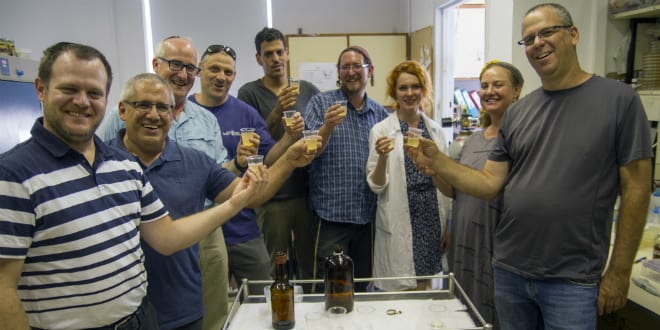Hundreds of breweries around the world work hard to make the best beer in a complicated process, even though the alcoholic beverage is made from four basic ingredients – barley (but sometimes rye or wheat), water, hops and yeast. They must extract the sugars from grains so that the yeast can turn it into alcohol and CO2.
Malting is carried out to isolate the enzymes needed for brewing. The grains then go through a process known as mashing, in which they are steeped in hot water for about an hour, sort of like making tea. This activates enzymes in the grains that cause it to break down and release its sugars. The water is drained, leaving a sort dough for bread that is boiled while hops – the small, green cone-like fruit of a vine plant – and other spices are added. Once cooled, strained and filtered, it’s put in a fermenting vessel and yeast is added for fermentation.

The beer is stored for several weeks at room temperature or a cold temperature (depending on whether it is ale or lager). The flat beer is bottled, at which time it is either artificially carbonated like a soda or allowed to naturally carbonate from the carbon dioxide that the yeast produces. And, viola, there is beer.
But beer has been consumed for thousands of years. What kind of beer did Pharaoh or the Philistines drink? In ancient times, beer was an important ingredient in people’s daily diet. Great powers were attributed to beer in the ancient world, particularly for religious worship and healing properties. The pottery used to produce beer in antiquity served as the basis for this new research.
Dr. Ronen Hazan and Dr. Michael Klutstein, microbiologists from the School of Dental Medicine at the Hebrew University of Jerusalem, led the study. They examined the colonies of yeast that formed and settled in the pottery’s nano-pores. Ultimately, they were able to use resurrect this yeast to create a high-quality beer from about 5,000 years ago. Their research has just been published in the Journal of Ecological and Evolutionary Science of the American Society of Microbiology.
Many “cooks” were invited into this “beer kitchen” to isolate the yeast specimens from the ancient debris and to create a beer with it. First, the scientists reached out to vintners at Kadma Winery, located at Kfar Uriah just halfway between Jerusalem and Tel Aviv. It is said to be the only winery in Israel that uses clay casks as part of the production process – proving that yeast may be safely removed from pottery, even if it had lain dormant in the sun for years.

The yeast was then photographed by Dr. Tziona Ben-Gedalya at the Eastern R&D Center of Ariel University in Samaria. After her initial examination, the team reached out to archeologists Dr. Yitzhak Paz from the Israel Antiquities Authority (IAI), Prof. Aren Maeir at Bar Ilan University and Profs. Yuval Gadot and Oded Lipschits from Tel Aviv University. These archeologists gave them shards of pottery that had been used as beer and mead (honey wine) jugs back in ancient times—and miraculously, still had yeast specimens stuck inside.
These jars date back to the reign of Egyptian Pharaoh Narmer (roughly 3000 BCE), to Aramean King Hazael (800 BCE) and to Prophet Nehemiah (400 BCE) who, according to the bible, governed Judea under Persian rule.
With the help of Hebrew University student Tzemach Aouizerat, the researchers cleaned and sequenced the full genome of each yeast specimen and turned them over to Dr. Amir Szitenberg at the Dead Sea-Arava Science Center for analysis. Szitenberg found that these 5,000-year yeast cultures are similar to those used in traditional African brews, such as the Ethiopian honey wine tej, and to modern beer yeast.
Now it was time to recreate the ancient brew.
Local Israeli beer expert Itai Gutman helped the scientists make the beer and the brew was sampled by Ariel University’s Dr. Elyashiv Drori, as well as by certified tasters from the International Beer Judge Certification Program under the direction of brewer and Biratenu owner Shmuel Nakai. The testers gave the beer their approval, deeming it high-quality and safe for consumption.

“The greatest wonder here is that the yeast colonies survived within the vessel for thousands of years – just waiting to be excavated and grown,” said Hazan. “This ancient yeast allowed us to create beer that lets us know what ancient Philistine and Egyptian beer tasted like. By the way, the beer isn’t bad.
Aside from the gimmick of drinking beer from the time of King Pharaoh, this research is extremely important to the field of experimental archaeology – a field that seeks to reconstruct the past. Our research offers new tools to examine ancient methods, and enables us to taste the flavors of the past.”
“We are talking about a real breakthrough here,” added Paz. “This is the first time we succeeded in producing ancient alcohol from ancient yeast. In other words, from the original substances from which alcohol was produced. This has never been done before.”

Gadot, of Tel Aviv University’s department of archeology and ancient near-eastern cultures noted: “We dug at Ramat Rachel, the largest Persian site in the Judaean kingdom [that became a kibbutz just outside Jerusalem] and found a large concentration of jugs with the letters J, H, D Yahud – written on them. In a royal site like Ramat Rachel it makes sense that alcohol would be consumed at the home of the Persian governor.”
Maeir of Bar-Ilan University’s department of the Land of Israel studies and archaeology concluded: “These findings paint a portrait that supports the biblical image of drunken Philistines.”
Source: Israel in the News

